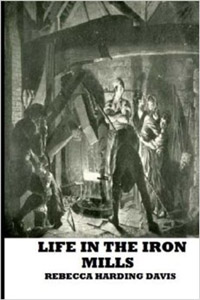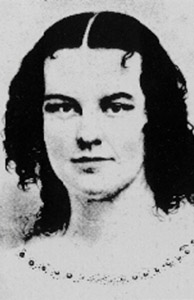
photo by Gary Robson
by Pat Tompkins
When I first encountered the paperback anthology Four Stories by American Women, three of the stories were already familiar to me: ‘The Yellow Wallpaper’ by Charlotte Perkins Gilman, ‘The Country of the Pointed Firs’ by Sarah Orne Jewett, and ‘Souls Belated’ by Edith Wharton. But ‘Life in the Iron Mills’ by Rebecca Harding Davis was a revelation on several levels.
It is about a worker in an iron factory and his attempt and failure to find consolation by carving figures, creating art from the mill’s dross. The story’s subtitle – ‘or the Korl Woman’ – refers to a statue he makes that draws the attention of a group of men who visit the iron works one Saturday night. They include the overseer, a reporter and a doctor. The worker is a Welsh immigrant, Hugh Wolfe. He is admired by a cousin, Deborah, who is worn down by work and poverty and burdened by a deformed back. Deborah’s unrequited love drives her to an act that has terrible consequences.
 ‘Life in the Iron Mills’ was the author’s first published story, a spectacular debut. When it appeared in The Atlantic Monthly during 1861, it attracted attention and praise. Nothing else she wrote has endured the way this story has. At a time when women writing stories often composed polite accounts of society, where plots pivot on matters of manners, Davis is rough and tumble. Unlike the stories by the other three writers in the anthology, her main character is a man. Not a gentleman, but an ironworker in Virginia during the 1830s. In addressing problems of capitalism, religion, and crime, it questions the assumption that a man can improve his station through hard work and talent. How is an artist to make his way without money? The salvations of love, beauty, and art fail this labourer.
‘Life in the Iron Mills’ was the author’s first published story, a spectacular debut. When it appeared in The Atlantic Monthly during 1861, it attracted attention and praise. Nothing else she wrote has endured the way this story has. At a time when women writing stories often composed polite accounts of society, where plots pivot on matters of manners, Davis is rough and tumble. Unlike the stories by the other three writers in the anthology, her main character is a man. Not a gentleman, but an ironworker in Virginia during the 1830s. In addressing problems of capitalism, religion, and crime, it questions the assumption that a man can improve his station through hard work and talent. How is an artist to make his way without money? The salvations of love, beauty, and art fail this labourer.
After an opening reminiscent of the first page of Bleak House, in which miserable weather sets the tone, Davis introduces her subject, the tale of what went wrong for a laborer in the mill. Amidst some flowery language comes this direct call:
Stop a moment. I am going to be honest. This is what I want you to do. I want you to hide your disgust, take no heed to your clean clothes, and come right down with me – here, into the thickest of the fog and mud and foul effluvia. I want you to hear this story.
This story is not a masterpiece. It is a powerful but flawed work. It contains symbolism that feels dated and, befitting the subject, it is not subtle. It includes ethnic dialogue, which I think trips up most writers who attempt it, as it does Davis:
“Begorra! on the spools. Alleys behint, though we helped her, we dud. An wid ye! Let Deb alone! It’s ondacent frettin’ a quite body. Be the powers, an we’ll have a night of it! There’ll be lashin’s o’ drink – the Vargent be blessed and praised for’t!”
 As someone who has worked for many years as an editor, I wish the story were tighter. It is crowded and messy. The characters include: the carved woman whose face of desperation seems to ask, ‘What shall we do to be saved?’; the well-meaning doctor, who tells Wolfe, ‘Make yourself what you will. It is your right’; the cynical brother-in-law of the mill owner who declares that money is ‘the cure for all the world’s diseases’; the reformer preacher who ‘meant to cure this world-cancer with a steady eye that had never glared with hunger, and a hand that neither poverty nor strychnine-whiskey had taught to shake.’
As someone who has worked for many years as an editor, I wish the story were tighter. It is crowded and messy. The characters include: the carved woman whose face of desperation seems to ask, ‘What shall we do to be saved?’; the well-meaning doctor, who tells Wolfe, ‘Make yourself what you will. It is your right’; the cynical brother-in-law of the mill owner who declares that money is ‘the cure for all the world’s diseases’; the reformer preacher who ‘meant to cure this world-cancer with a steady eye that had never glared with hunger, and a hand that neither poverty nor strychnine-whiskey had taught to shake.’
‘Life in the Iron Mills’ brings us a view of outsiders, those ignored and disdained by the wider society. As the best short stories do, it gives voice to the lonely, which Frank O’Connor explained in his masterful anthology The Lonely Voice. It is difficult, especially some 150 years later, to appreciate the novelty of something once fresh, or the boldness of the young woman who wrote the story. But it is worth recalling that similarly gritty fiction, by such noted American authors as Stephen Crane, Frank Norris, and Theodore Dreiser, did not appear until decades later. This is a story of its time that still matters.


Interesting. I think I’ve seen references to Davis, but never read any. One to look for! Ta muchly.